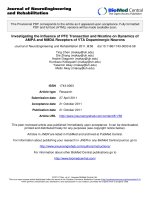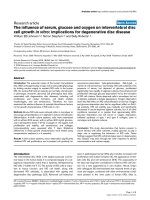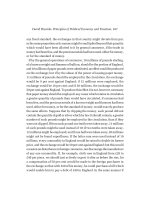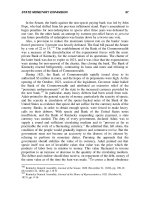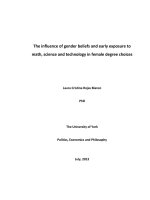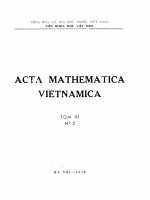Supported nanosized gold catalysi the influence of support morphology and reaction mechanism 6
Bạn đang xem bản rút gọn của tài liệu. Xem và tải ngay bản đầy đủ của tài liệu tại đây (39.42 KB, 6 trang )
181
Chapter 6 Conclusion
In this thesis supported nanogold catalysts on low temperature CO oxidation are
intensively studied. Three types of easily reduced oxides, i.e. iron oxides, titanium
oxides and copper oxide are used as the support. Also three preparation methods, i.e. co-
precipitation, deposition-precipitation, and colloid-based impregnation are employed for
preparing Au catalysts with Au particle size around 2-4 nm. The performance of Au/iron
oxide catalysts towards PROX reaction was found to be strongly affected by catalyst
preparation and post-treatment. Among the three methods studied in this chapter, the
colloid-based method is better than the co-precipitation and deposition-precipitation
methods. The AuCH sample (Au catalyst supported on Fe
2
O
3
prepared by the colloid-
based method) showed the highest activity, selectivity and stability at temperatures
between RT and 100
o
C. The reaction rate r
co
for the CO+O
2
CO
2
at 25
o
C was measured
to be 12.3 x 10
-4
mol
co
* g
Au
-1
* S
-1
, better than that reported in literature, i.e. 4.87 * 10
-
4
mol
CO
g
-1
Au
S
-1
for Au/-Fe
2
O
3
, provided by the World Gold Council. With the colloid-
based method, Au particle size and distribution can be better controlled. Provided that
gold particles in all the four Au/iron-oxide samples prepared by various methods are
small enough to be able to activate CO and O
2
, the CO oxidation activity was found to
remarkably depend on the structure of the iron oxide support, in the order: ferrihydrite >
hematite > magnetite. XRD, TPR, XPS and SIMS studies showed the presence of OH
and COO groups on the AuCH samples. Moreover, non-metallic Au has been detected in
182
the AuCH sample in addition to metallic Au. All these would contribute to the enhanced
activity of the AuCH sample.
In Chapter 4 Au supported on six different types of TiO
2
are studied. Compared to the
commercial anatase TiO
2
(CB) and 4 kinds of TiO
2
samples from KAISHA Ltd, the
home-made TiO
2
nanotubes (NT) are better catalyst support, on which the Au
nanoparticles exhibit significantly improved catalytic activity for the CO oxidation at
room temperature. Surface area is found to be an important factor for catalysts’ activity,
since higher surface area samples show higher activity. However, Au/TiO
2
(NT) and
Au/MC150, one of the Kaisha samples, have similar surface areas but exhibit remarkably
different activity. In depth studies in this chapter showed that TiO
2
nanotubes are a better
support because they have smaller sizes (<10 nm), higher defects density, and more
chemically bonded OH groups or water molecules, which result from the hydrothermal
processing for preparing TiO
2
tubes from TiO
2
particles.
Chapter 5 demonstrates that the catalytic activity of Au/CuO catalysts could be
significantly improved for CO oxidation at room temperature using the nanosized
supports, i.e. home-made CuO (NF) and CuO (NP) as compared to the commercial
CuO(CB). The Au catalysts prepared by colloid-based method on the three CuO supports
have similar gold particle size and size distribution. XRD showed that all the three CuO
supports have the same crystalline structure. Au/CuO(NP) catalyst with larger support
surface area showed better catalytic activities. Under the same reaction conditions, the
activation energy was measured to be 3.8 KJ/mol in a temperature range of 25-125
o
C for
Au/CuO (NP), and 5.8 kJ/mol for Au/CuO (CB). The reaction rate was 0.22 mmol/g
Au
·s
for Au/CuO (NP) and 0.07 mmol/ g
Au
·s for Au/CuO (CB). The pre-treatment temperature
183
was found to affect the samples’ catalytic activity, and 300
o
C is the optimum temperature
for air pre-treatment.
DRIFTS study showed that Cu ions on the CuO supports are mainly in +1 oxidation state,
indicating there exist high oxygen vacancies on the CuO support surfaces. CO was found
to be mainly adsorbed at Au active sites. Surface –OH groups were detected on Au/CuO
samples prepared by the colloids-based method. They were found to be involved in the
CO oxidation reaction via the interaction with adsorbed CO, forming HCOO
intermediates. Higher concentration of OH groups was measured on Au/CuO(NP) with
higher CO oxidation activity (than Au/CuO(CB)). O
2
could be adsorbed with the CuO
samples, forming O
-
or O
2
-
species, which might react with surface HCOO to release CO
2
via carboxylate or carbonate intervidiates. In the presence of CO + O
2
, Au
-
, Au
0
, and
Au
n+
could be simultaneously found on the Au/CuO samples, as evidenced by the
detection of C-O vibrations at 1978, 2104, 2164 and 2189 cm
-1
. Au
n+
can adsorb and
activate CO stronger. Strong support-metal interaction was observable on Au/CuO(NP)
which showed higher CO oxidation activity. The reaction mechanism derived from the
in-situ DRIFT studies is basically the same as those proposed by G.C. Bond and H.H.
Kung.
In summary, the study in this thesis indicated that the improved colloid-based method
(employed in our lab) is better than conventional co-precipitation and deposition-
precipitation methods in controlling the Au dispersion and introducing more OH and
COO groups. Hydrothermal processing of catalyst support could result in more structural
defects and more chemically bonded OH groups so that can improve the CO oxidation
activity on these oxide-supported Au catalysts. The Au/Fe
2
O
3
and Au/TiO
2
catalysts
184
prepared using colloid-based method can achieve very good activity. In-situ DRIFTS
study of the CO oxidation over Au/CuO could detect the presence of various Au species
as well as a variety of reaction intermediates including formate, carbonate, and
hydrocarboxylate, allowing the derivation of a reaction mechanism similar to those
proposed by G.C. Bond and H.H. Kung. All these results provide deep insights on the
gold catalysis and valuable guidance for future study of it.
In this thesis the investigation is started from the one of the most effective metal oxide
supported nano-gold catalyst—Au/Fe
2
O
3
, whose activity greatly depends on the method
of preparation. After comparing the catalytic results of Au/Fe
2
O
3
samples prepared using
different methods, it is found that the best preparation method is colloid-based method.
Then in the next chapter titanium oxide – one of the earliest and most investigated
support for gold nano particles is chosen as the support. Although both experimental and
theoretical researches concerning the effect of gold nanoparticle’s size have already been
conducted comprehensively, the research on titanium oxide support still has some gap to
fill. The catalytic performance of various Au/TiO
2
samples, prepared with same method
and having similar gold dispersion, similar gold particle size, but different surface area,
different morphology and different crystalline structure of support, were carefully studied.
By comparing these results, it is found that the properties of oxide support significantly
affect the catalytic performance of Au/TiO
2
samples. With the same preparation method,
TiO
2
having more –OH functional groups shows higher catalytic activities for CO
oxidation over Au/TiO
2
. Also the catalytic performance is found to increase with
increasing support surface area. These findings provide clear guidelines on how to
choose metal oxide for supported nano-gold catalysts. Easily reducible metal oxide such
185
as Fe
2
O
3
which have more defects and larger surface area should have better catalytic
performance than less- and non-reducible metal oxide supports, including TiO
2
, CeO
2
,
ZrO
2
, MgO, Al
2
O
3
and SiO
2
. In Chapter 5, an oxide that has not attracted much attention
and have not been extensively investigated CuO (copper oxide) is chosen to be the
support for nano-gold catalyst, and the experimental results in this chapter prove the
above conclusion on how to prepare and improve metal oxide supported nano Au
catalysts.
Due to the novelty and wide applications nano-gold catalysis has received increasing
interest and attention. More systematic work can be carried out in future to understand
how the use of capping agent in colloid-based impregnation method and the post-growth
treatment can well control the gold particle distribution and improve its catalytic
performance. Advanced technologies such as high resolution scanning TEM, in-situ FTIR,
XPS can be employed to determine the nature and structure of the active center over the
nano-gold catalysts: whether bi-layer gold cluster is essential for CO oxidation, what are
the gold oxidation states under reaction conditions, where oxygen is activated, what is the
activated oxygen intermediate states, and how water or OH functional groups participate
in the CO oxidation. For wider catalytic applications of supported nano-gold catalyst,
some ‘reactive transition metal oxides’ such as NiO that have proved to be beneficial to
the oxidation reaction but have not been often used as the support for nano-Au catalysts
can be tested. Mixed or composite metal oxide support and alloy catalysts can be
considered too. For example, mixture of one easily reducible metal oxide and one
irreducible metal oxide with more defects may be studied as the support for nano gold
particles. Gold nano particles with another noble metal as a bimetallic catalyst supported
186
on single metal oxide support can be another research interest. They may be used for
water gas shift reaction, selective reduction of nitric oxide, propene oxidation and other
chemical processes.



